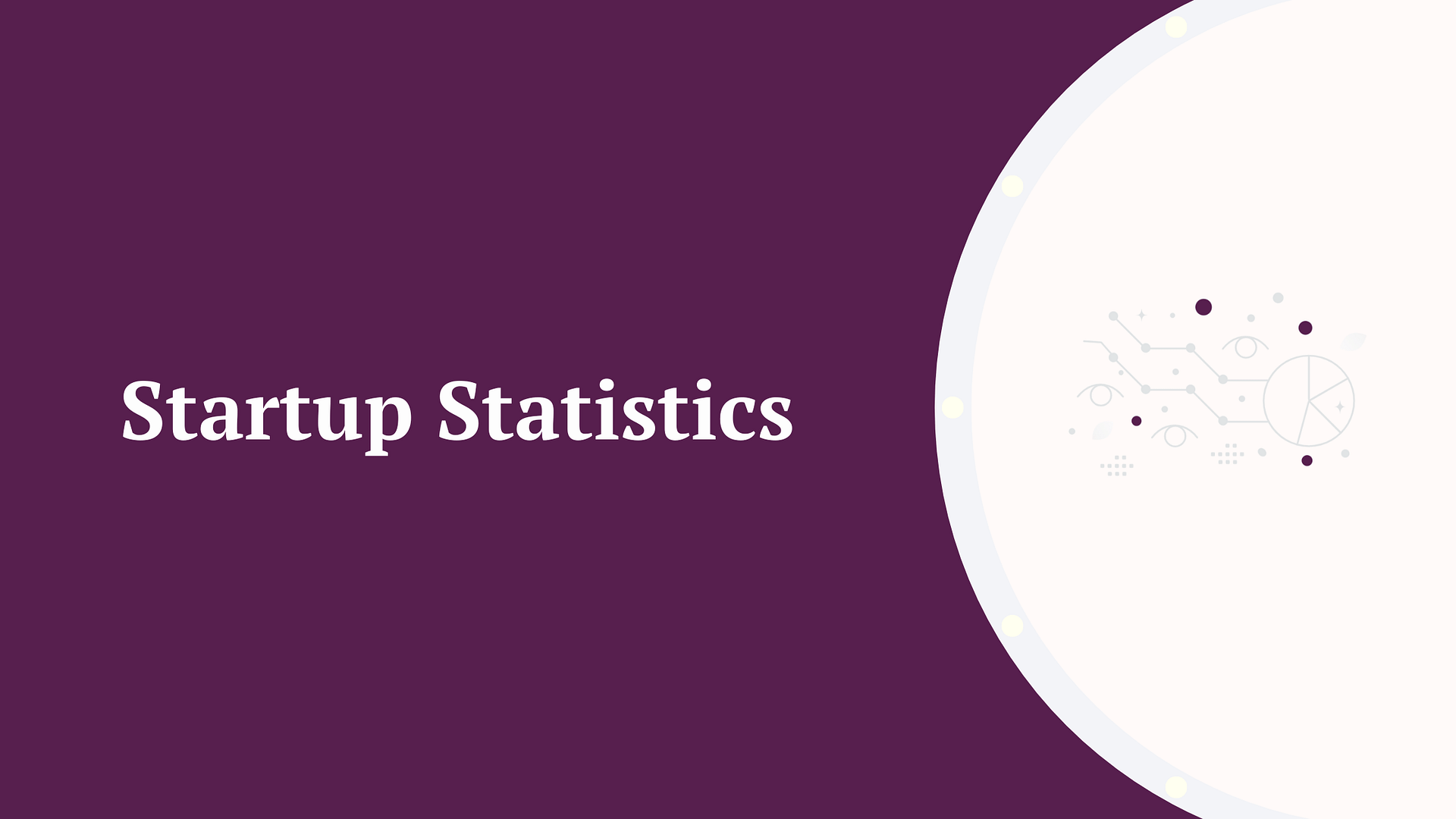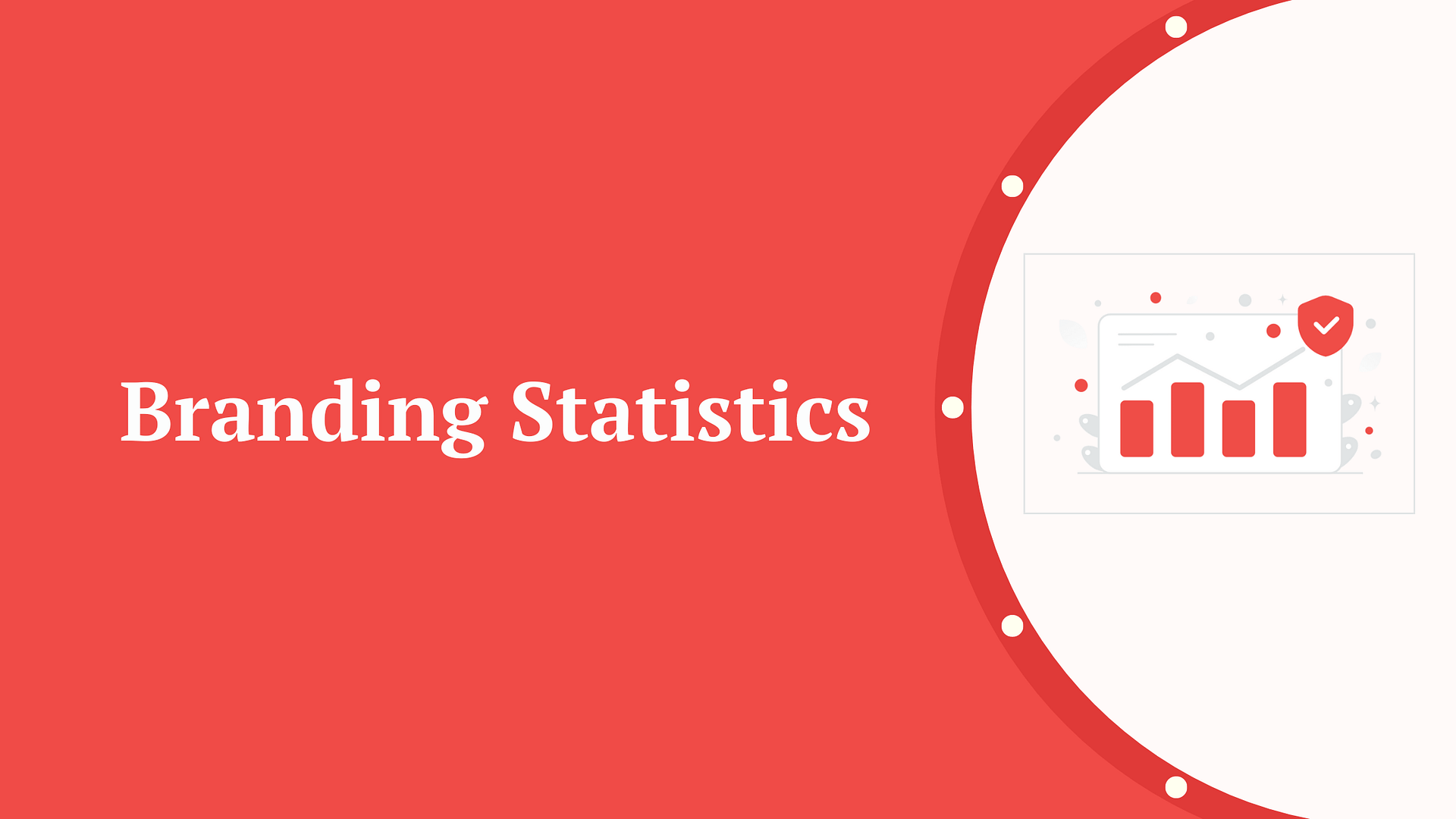A good flip can be an extremely profitable venture, and for many people it’s life-changing. Even for those of us who have been in the website flipping business for some time, a good flip is still incredibly exciting.
This case study is a perfect example of how I bought a site for $23,000 and sold it for $175,000 in less than two years. This outdoor site was one I found through my normal search and due diligence process and upgraded it over time to get to the sale.
Here is a screenshot showing the Escrow transaction:
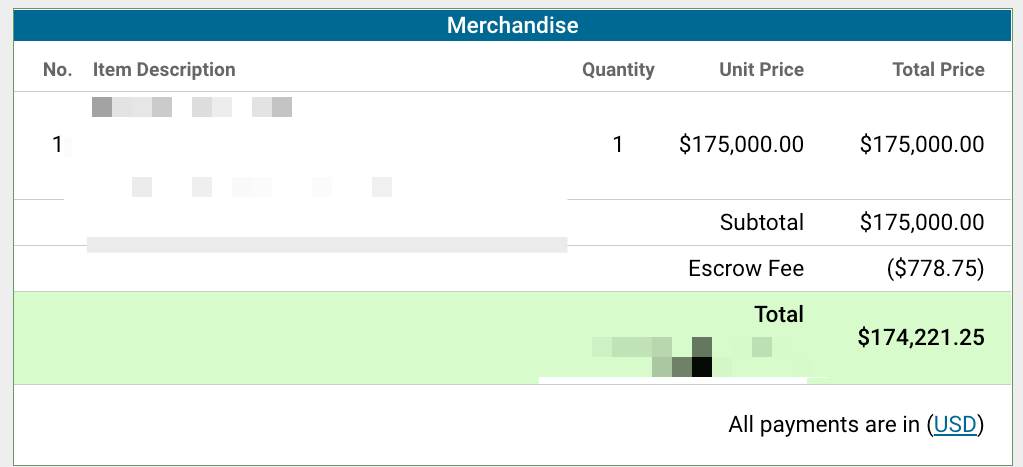
Let’s take an in-depth look at the site, the signals, and the steps that were taken to make this successful website flip possible.
📚 Table of contents:
- What’s a Niche Content Website?
- Site Purchased for $23,000 From Flippa
- What I Liked About the Website
- How Did I Grow the Site From $300/mo to $4,000/mo Earnings?
- Traffic and Revenue Metrics
- How I Sold the Site for $175,000 Privately
What’s a Niche Content Website?
A niche content website is a website focusing on one specific topic (niche) and producing a large number of quality articles covering a variety of subtopics within that niche.
The majority are built in WordPress, which is the best Content Management System (CMS) out there. This also makes it easy to build up, transfer, or find information on plugins and other built-in benefits that non-WordPress sites won’t be able to take advantage of.
The details on themes used and plugins vary since there are many options, but smart niche site builders are going to build sites that have some things in common, such as:
- A premium theme, like GeneratePress (or Neve)
- A caching plugin, like WP Rocket
- Image optimization plugin, like ShortPixel (or Optimole)
- Reliable fast hosting, like Cloudways
Monetization often focuses on display ads or affiliate programs. Google AdSense and Amazon Associates are common beginning options, while most niche sites add in more lucrative affiliate programs and better ad display programs, like Ezoic, Mediavine, or AdThrive.
Some niche sites also increase monetization by using video ads, lead generation, digital products, and other methods.
Traffic mostly comes from organic search via search engines, like Google. Niche site owners use on-site and off-site SEO to make their content more attractive to the search engines. Some site owners also get traffic from social media, podcast appearances, and links from other popular sites, but the organic search traffic is always the primary goal and almost always the lion’s share of traffic that is going to a site.
One of the major benefits of niche websites is that you can get into website flipping and sell these sites for 35 to 45 times their average operational profits. It’s a great way to get a large lump-sum payment upfront.
Site Purchased for $23,000 From Flippa
I saw this site originally listed on Flippa. It was only earning $300 a month despite some very good authority indicators, including good traffic and great links.
Rather than get drawn into a bidding war, I contacted the owner to see what would be an acceptable “Buy Now” price. We settled on $23,000, and that was the price I bought the site for in April of 2020.
What I Liked About the Website
There were some very strong signals from this website that caught my immediate interest and led to me being willing to pay above the market rate to purchase it.
The short bullet list:
- 60,000-90,000 page views per month on average (seasonal traffic variances)
- Ahrefs DR of 51 with many excellent high-authority backlinks from NY Times, Wikihow, Wikipedia, NY Post, Marketwatch, and 2,000 other niche-relevant domains
- 10-year history (website has been active since 2010)
- 863 articles already published, 849,778 words total
- 12 different revenue streams, including Amazon Associates, private brand partnerships, affiliate networks, and display ads
- Email campaign with 32 email stack that gets sent to new subscribers
- Two dedicated writers who are both clear experts in this niche
Let’s break these down in a little more detail.
Excellent Starting Traffic
Since this is an outdoors site the traffic was subject to seasonal changes. Summer was the best season, while winter months were more of a struggle. The average monthly traffic would be around 60,000 in the low-traffic months and could shoot up to 90,000 during the high-traffic months.
This is good traffic that was heavily under-monetized, and I was confident that I could very quickly boost the monthly revenue numbers from month one.
Strong Profile
The screenshot from Ahrefs when I was doing due diligence on the site looked like this:
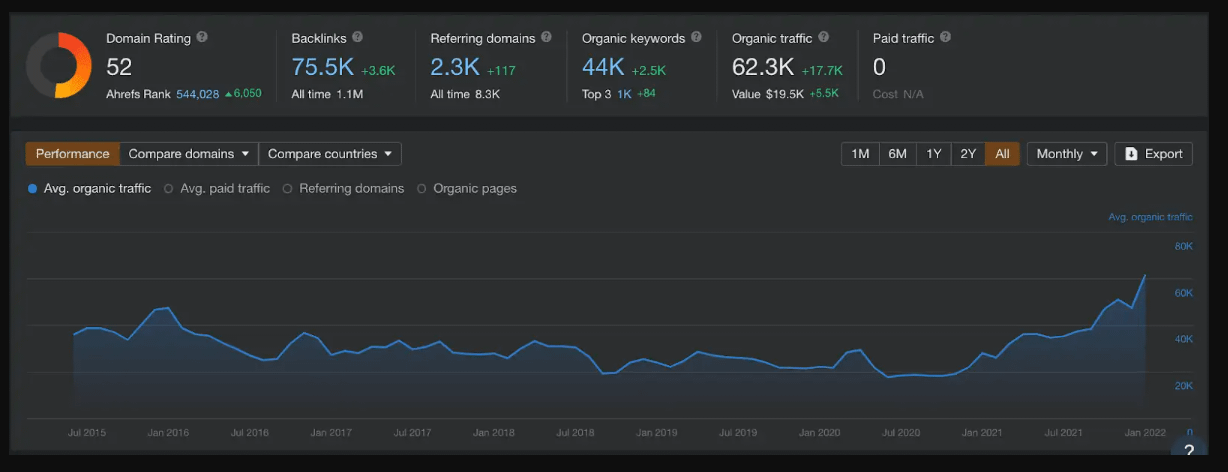
Right away, that is a strong domain rating at 52, and many consider this authority site levels of rating. The traffic levels are solid and a further delve into the backlinks showed even more good news – multiple authority links.
As I mentioned, it had links from trusted authority sites like Wikipedia, NY Times, NY Post, Wikihow, MarketWatch.
These are hard-to-get backlinks, and they’re links that give a large amount of trust and authority in the eyes of Google.
In addition to this, there were over 2,000 links from domains in the same, related, or directly parallel niches. These related referring domains give trust and authority to the site as a whole.
Long History and Good Content
The main authors were two niche experts who clearly knew the topics they wrote about inside and out. This brought a lot of authority to the content on the site and earned the trust of Google and other search engines.
The long history of the website also contributes to this in a big way. Finding a good 10-year-old site that is available isn’t common. That history combined with the content written by experts made it an especially appealing choice.
Active Email List
Email lists are a bonus, and this one was active, which is important. This meant new sign-ups were engaged and that added some additional value to the site in my eyes.
This doesn’t mean I wasn’t going to double-check the scripts and make changes to optimize, but it means things were in place to make sure it wasn’t a dead list.
Easy Wins
Despite the very strong signs, I also saw multiple easy wins. I saw monetization improvements that weren’t being used, saw many articles were based on general topics versus keyword research, and more.
There were many places where I could drastically improve the site from an SEO and monetization standpoint in month one, which further made this site a very attractive target.
How Did I Grow the Site From $300/mo to $4,000/mo Earnings?
Once I bought the site, improving monetization was an important priority. There was already a lot of expertly written content and very good traffic – so improving that paltry $300/month number was the top priority.
There were five actions I took immediately to improve the earnings of the purchased website:
Add Comparison Tables to Affiliate Content
Comparison tables are the best way to convert on affiliate offers. This lets readers who trusted the content to see large call out buttons, clear pictures, and concise comparisons of the main stats and features that entice them to buy.
This is far better than just a couple of words linked by long paragraphs of text. Any article that had affiliate offers or was covering clear affiliate-friendly content was a place where I was adding comparison tables for the best products or offers available.
Added Display Advertisements
This was a site built heavily around many affiliate topics, but adding display ads was still a good way to increase revenue. I didn’t feel this was a good fit for Ezoic because of the reduction of page speed, which was a major issue at the time. I went with Newor Media since they allowed me a lot of control over adding display ads for residual income without affecting site speed or user experience.

This meant lower revenues, but especially when optimizing for SEO, improving the site, and scaling the improvements, keeping a good user experience was far more important to me.
I also added video play ads through Ex.co to supplement the revenue without interfering with the overall user experience of the site.
Ezoic would be added at a later date when a lot of the initial scaling and revising of content and other site optimization work had been completed.
Added 13 Diversified Revenue Streams
I’m a firm believer that it’s a bad idea to rely on just one or two income sources for your site. An outdoor site that was on such a popular (and broad) topic offers many opportunities to make money and diversify the incoming revenues.
Some of these steps included:
- Working out deals for direct banner placements with companies
- Adding display ads
- Adding video ads
- Purchasing multiple ebooks to sell as digital products
- Additional deals with brands sold through Amazon
- Joined multiple affiliate programs that were not cutting commissions the way Amazon was
- Rented out the email list (editor’s note: not advisable concerning international data privacy laws)
These brought in additional streams of revenue on top of increasing the income generated from existing sales and traffic.
Performed a Full Website Redesign
While the site had a lot of things going for it, the overall design was not one of them. I performed a full website redesign to get a more modern look with a premium thing that loaded quickly when visited.
Some things I focused on with the redesign included:
- Moving to Carbonate Theme from GeneratePress (Carbonate was just a very good fit for this site)
- Disabled all unnecessary plugins
- Better user experience
- Better organization of existing content by removing over 100 articles and merging dozens of others through the use of 301 redirects
- Ability to customize individual pages
- Clean, fast-loading theme that is SEO-friendly
If you think about this in terms of real estate investing, this website was an old house with good character, but the redesign was the equivalent of cleaning up, improving, and setting the stage for new tenants to move in.
The redesign is a major part of setting the foundation for future content pushes, optimization, and other factors that will determine whether the project would succeed or fail.
Added 336,333 Words of Content
Some of this content was added to existing articles through editing and revision, but much of it went to brand new articles. The site has a lot of authority, and I wanted to get as much content out based on keyword research as possible.
This would give it time to index, rank, and gain its full potential. Assuming I held the site long enough, which in this case I did, I would also go back to revise and improve old content based on the results produced and where the most potential is to grow even more traffic, and by extension, more revenues.
Traffic and Revenue Metrics
This focus on keyword-researched articles caused a jump in traffic, though the site was hit by the Google Core Update in December 2020, returning traffic to lower levels – which, based on analytics, would have been far worse without the new content.
Here are how the 2021 numbers played out:
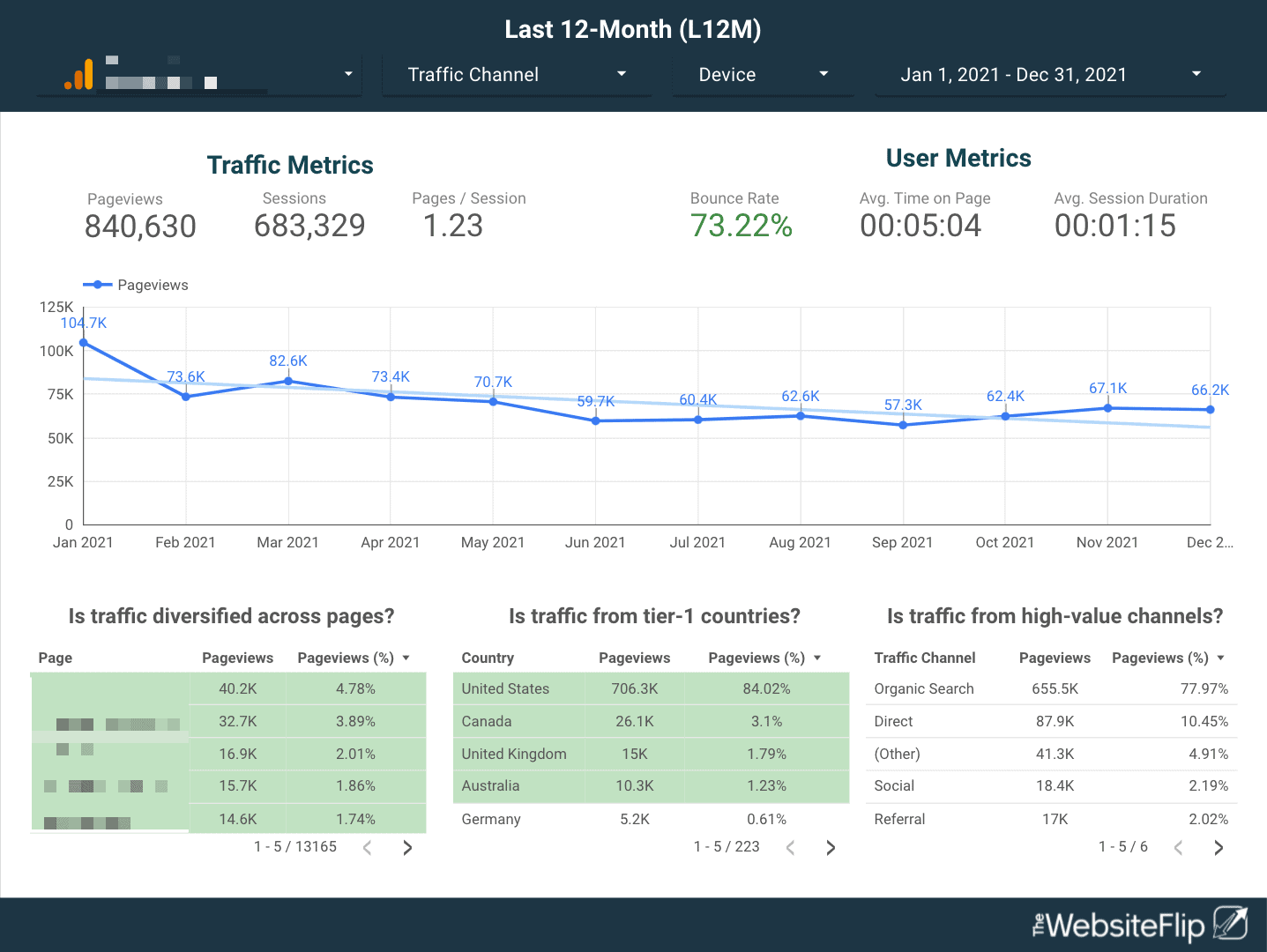
In total, over the year the site generated an excellent 840,630 page views with the highest performing page getting 4.78% – which is excellent because I always want to see the top page getting less than 15% of traffic.
The on-page time is exceptional at five minutes, and the bounce rate is very healthy at 73%. These are the types of metrics that would pass my stringent due diligence standards if I was looking to purchase or acquire it.
The plan for 2022, had the sale not taken place, was to double down on content. Between identifying already outsourced content that could have been better (my fault for not checking on the writer earlier) and more topics that hadn’t yet been covered, there was still plenty of room for major traffic growth.
Revenue and Cost Breakdown
The total revenue numbers and costs are tracked on the following graph on a month-by-month basis:
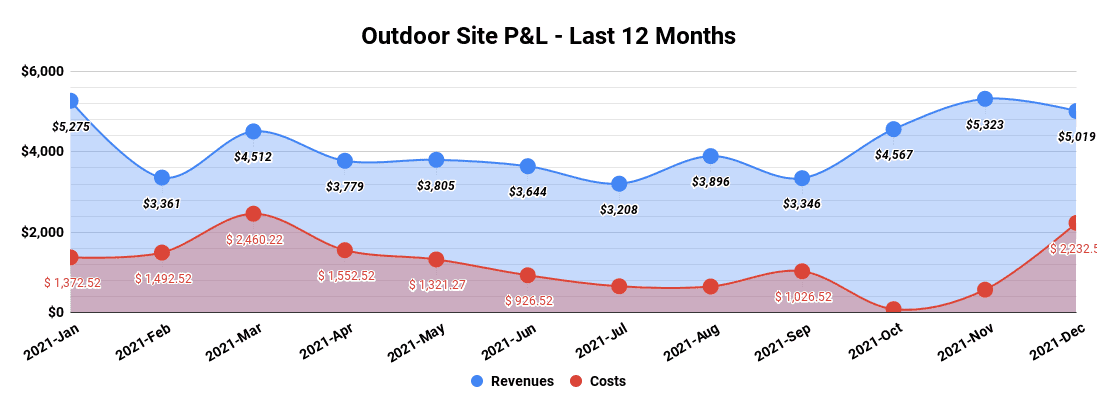
Over the course of 2021, this lead to totals of:
- $49,735 in total revenue
- $14,334 in total costs
- $35,401 in total profits
In my case, the content was (surprisingly) not the overwhelming majority of my costs, although it was the single highest cost. The cost breakdown for the 2021 year was:
- Content – $6,409
- Virtual Assistants/Web Operator – $6,164
- New Website Design – $1,560
- Software/Hosting – $200
This means the net margin is 71%, but the operating margins are 97% meaning once the site moves from growth mode to maintenance mode, the overwhelming majority of the revenue becomes hands-off passive.
This can (and did) work as a major selling point for a successful flip.
How I Sold the Site for $175,000 Privately
This website flip was completed via a private sale. I’m a big fan of private sales and think it’s ideal for many large sales. Why is this?
- Doesn’t leave the sales price up to chance as auctions do
- Can often negotiate better terms with savvy buyers who know how to improve the site once bought
- Direct negotiations allow for setting up a simple process of payment and transfer
- There’s a smaller group of buyers for higher-cost sites
- There’s no cut paid to brokers for facilitating the deal
These are just some benefits when doing a private deal, and cutting out that broker commission is no small thing when a sale reaches a $175,000 price tag. I found my buyer through my network, but this option obviously isn’t available to others.
If outreach doesn’t result in being able to find a private sale, going the broker route is likely to be the best option and provides a variety of great benefits.
A reliable broker provides a secure place where motivated buyers can find motivated sellers. They help facilitate the selling process, including the setup of escrow, and that additional support and protection can be invaluable, especially for inexperienced sellers.
Brokers like Empire Flippers, Motion Invest, and FE International can all provide reliable services for selling sites and have a high success rate. The cost can vary based on provider as Empire Flippers is 15%, FEI is 10-15% on average, 15-20% fee for Motion Invest if sold to a buyer (or 0% if they buy the site outright for themselves).
On the negative side, larger sites are simply harder to move at asking price on brokerages and often take longer to sell.
There’s also that commission, which means less money directly into the seller’s pocket.
Actionable Takeaways
I hope this case study was eye-opening as to what is possible. Buying, growing, and successfully flipping a website is a lot of work and it’s not easy, but it is possible!
- I’m willing to pay above market multiple for the right website if everything else looks exceptional
- Do major site redesigns in month one
- Early easy monetization wins are crucial to reinvest into building the site
- Adding more content is always part of the action plan
- Diversify revenue sources
- Check on your writers and outsourcers to confirm their work is up to par
- Find a private sale when possible
The actions outlined in this website flip can be copied and cloned. While each website and niche will be a little different, the concepts of building, improving, and flipping a website follow the same blueprint.
Look for the same positive signs when acquiring websites and take the same actions to improve content and monetization – that will pave the way for a successful (and profitable) website flip.

Mushfiq S
Mushfiq is a prolific investor who buys, grows, and sells online businesses, and specializes in content websites. He has done 200+ website flips to date and several have resulted in six-figure exits. He is experienced in all aspects of digital marketing and acquisitions.

